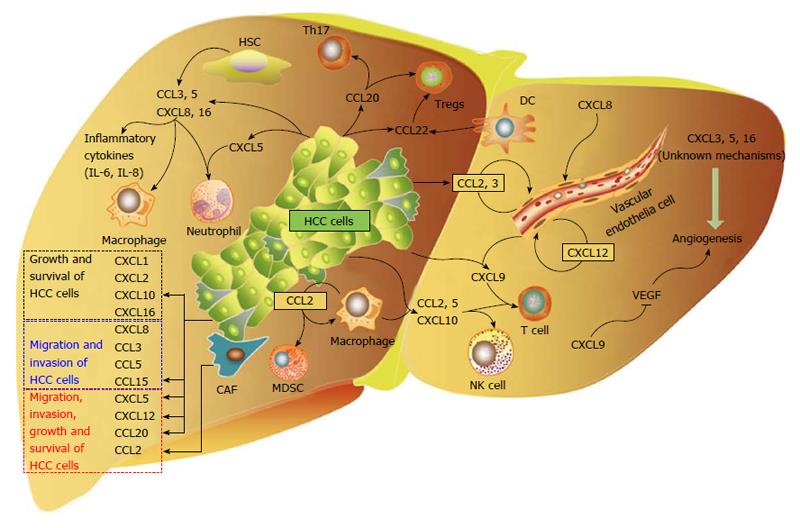Copyright
©The Author(s) 2015.
World J Hepatol. Jun 8, 2015; 7(10): 1390-1402
Published online Jun 8, 2015. doi: 10.4254/wjh.v7.i10.1390
Published online Jun 8, 2015. doi: 10.4254/wjh.v7.i10.1390
Figure 1 The complicated chemokine network in the microenvironment of hepatocellular carcinoma.
The chemokine system exerts pleiotropic effects in the microenvironment of hepatocellular carcinoma (HCC). Chemokines derived from either tumor cells or non-tumor cells induce potent inflammation response, along with increased levels of cytokines and infiltration of immune cells; the potent chemotactic effects of chemokines also lead to recruitment of various immune cells into the tumor sites, exerting both anti- and pro-tumor effects. Several other chemokines such as CXCL9 and CXCL12 manifest a key role in angiogenesis of HCC via different mechanisms. As the HCC cells intrinsically express chemokine receptors, they are directly influenced by chemokines too, which affect the behaviors of tumor cells such as the migration, invasion, growth and survival. Both the paracrine and autocrine mechanisms constitute this mutual complex network that is indispensible in HCC. Refer to the text for abbreviations. HSC: Hepatic stellate cell; IL: Interleukin; NK: Natural killer; CAF: Cancer-associated fibroblast; MDSC: Myeloid derived suppressor cells; Tregs: Regulatory T cells; DCs: Dendritic cells; VEGF: Vascular endothelial growth factor.
- Citation: Liang CM, Chen L, Hu H, Ma HY, Gao LL, Qin J, Zhong CP. Chemokines and their receptors play important roles in the development of hepatocellular carcinoma. World J Hepatol 2015; 7(10): 1390-1402
- URL: https://www.wjgnet.com/1948-5182/full/v7/i10/1390.htm
- DOI: https://dx.doi.org/10.4254/wjh.v7.i10.1390









